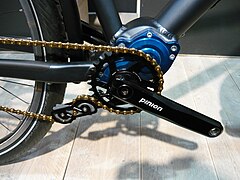Bottom bracket circuit

A bottom bracket shift is a shiftable gear transmission used as a gear shift on bicycles . The gearbox is together with the crank axle in most enlarged bottom bracket - housing accommodated. It is driven by the crank axle. The output takes place coaxially to the crank on the chain wheel .
history
Bottom bracket shifts were manufactured from the 1930s onwards by the companies Bismarck and Wanderer (two-speed), Adler (three-speed), Rappa (four-speed), Mutaped (three-speed) and BUEC ( Boite Universelle d'equipements pour Cycles - Vilex - five- speed). Was switched u. a. with the heel on the pedal axis.
Bottom bracket circuits had almost completely disappeared from the market in the second half of the 20th century. It was not until 1991 that the Swiss company Schlumpf Innovations presented a retrofittable bottom bracket transmission with two gears and heel gear at the inventors' fair in Geneva. In the years that followed, this resulted in the variants "Mountain Drive" (2.5: 1 and 1: 1), "Speed Drive" (1: 1 and 1: 1.65) and "High Speed Drive" (1: 1 and 1: 2.5). The gearboxes are now manufactured and sold by Haberstock Mobility . Pinion presented the 18-speed P1.18 gearbox at the Eurobike trade fair in 2010 . This circuit has been built into series bikes since 2012. At Eurobike 2014, lighter transmissions with 9 or 12 gears were also presented. Instead of these complex and expensive solutions, there are bottom bracket gears with a maximum of 5 gears, which are combined with another gear shift ( chain or hub gear ).
The reasons for the moderate commercial success of bottom bracket shifts are the high weight of the shifting components, which results from the high torque occurring at the bottom bracket , as well as the non-standardized design of the bottom bracket housing, which requires a special shape of the bicycle frame .
3-speed bottom bracket from Adler from 1936
historical bottom bracket circuit Mutaped
Schlumpf Speed Drive on a recumbent bike , planetary gear housing on the u. behind chainring
Designs / technology
Inside
In a model with four gears offered by the manufacturer Rappa, the entire transmission was located within a modified bottom bracket housing. The gears were shifted via a draw key within the axle, with which the sun gear of the respective planetary gear set was connected to the fixed axle. The Adler company produced a three-speed bottom bracket system from around 1934 to around 1945.
Outside
The transmission of the Swiss inventor Florian Schlumpf (great-grandson of Johann Georg Schlumpf ) can be retrofitted on all bicycles with a conventional bottom bracket. Two gears can be shifted via an external planetary gear set with four planet gears. It is switched via a pin in the bottom bracket axle, which can be switched back and forth using the heel kick of the left and right foot. The resulting torque of the gearbox is supported either by a separate torque arm or by a special tooth lock washer directly above the bottom bracket housing. The Schlumpf gear is available with a ratio of 1.6 or 2.5 or a reduction of 2.5 - in addition to the direct gear.
Gears with a gear ratio of 1.5 times to high speed that can be switched using a heel pin for unicycles - developed jointly by Schlumpf and unicyclist Kris Holm (KHU) in 2005 - are bottom bracket and hub gears at the same time.
See also
Web links
- Stiftung Warentest: Overview of bicycle gears with links to manufacturer documentation, October 25, 2012 (accessed on February 1, 2013)
- schlumpfdrive.com
- KH-Schlumpf unicycle gear
- PINION GMBH
Individual evidence
- ^ The bicycle history. Accessed on January 13, 2014.
- ↑ [Michael Embacher, Cyclopedia p. 22, 2014 Dumont]
- ^ Christian Wüst: Bicycles: Clockwork on the bottom bracket. In: Spiegel Online . August 30, 2010, accessed June 10, 2018 .
- ↑ Pinion website production start ( Memento from April 13, 2013 in the Internet Archive )
- ↑ http://www.eurobike-show.de/eb-wAssets/daten/neuheiten/pdf/EB14_neuheiten_bilder.pdf
- ↑ http://www.velo-zuerich.ch/velo-zuerich/velo/oldtimervelos/phoebus-velo-oldtimer-mutaped/phoebus-velo-oldtimer.htm
- ↑ Winkler, Rauch: Fahrradtechnik, p. 227





